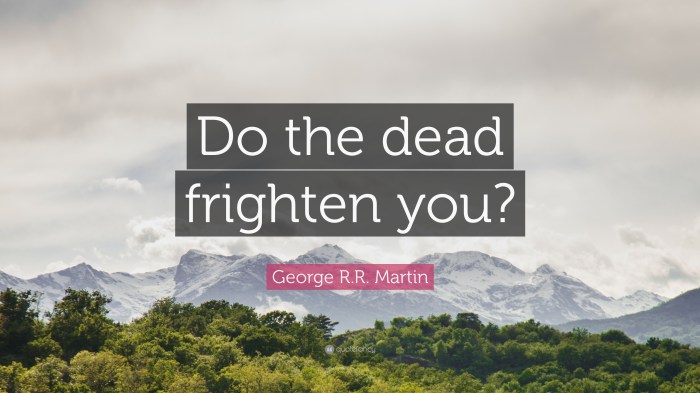
Would This Scare You? Exploring the Nature of Fear
Would this scare you? It’s a question we often ask ourselves, whether it’s about a spooky movie, a thrilling rollercoaster ride, or a looming deadline. Fear, a primal instinct that has helped us survive throughout history, is a complex emotion that shapes our experiences and influences our decisions.
This blog post delves into the nature of fear, exploring its psychological and physiological effects, its evolutionary purpose, and how it manifests in different situations.
We’ll examine the factors that contribute to our individual fear thresholds, from personal experiences to cultural influences. We’ll also discuss how the power of suggestion and the way things are presented can influence our perceptions of fear. Ultimately, we’ll explore strategies for confronting and managing fear, recognizing its potential for personal growth and empowerment.
The Power of Suggestion: Would This Scare You

The way we present information can significantly influence how scary it seems. Our minds are susceptible to suggestion, and the language we use, the images we conjure, and the context we provide can all shape our perception of fear.
The Impact of Language
The way we describe an event can dramatically alter its perceived scariness. Consider these two scenarios: Scenario 1:“The wind howled outside, rattling the windows. A sudden crash echoed through the house, followed by a chilling silence. I froze, my heart pounding in my chest.
Something was wrong.” Scenario 2:“The wind was a bit breezy, and the windows rattled slightly. There was a loud noise, probably just a branch hitting the house. I took a deep breath and realized it was nothing to worry about.”Both scenarios describe the same event: a noise in the house.
However, the language used in Scenario 1 evokes fear and suspense, while the language in Scenario 2 downplays the event and suggests a mundane explanation.
The power of suggestion lies in our ability to create vivid mental images.
Our imaginations can amplify fear, and the way we describe something can influence the images we create in our minds.
The Role of Imagination and Anticipation, Would this scare you
Fear often stems from our anticipation of what might happen. The more we imagine a terrifying outcome, the more likely we are to feel scared. This is why horror movies are so effective. They use suspense, sound effects, and visual imagery to create a sense of dread and anticipation, which amplifies our fear response.
Imagine you are walking through a dark forest. You hear a rustling in the bushes. You might start to imagine all sorts of terrifying creatures lurking in the shadows. Your imagination, fueled by the unknown, amplifies your fear.
The power of suggestion can be used to both enhance and alleviate fear.
By understanding how our minds work, we can learn to control our fear responses and avoid being overwhelmed by our imaginations.
Overcoming Fear

Fear is a natural human emotion that serves as a protective mechanism, alerting us to potential danger. However, when fear becomes excessive or irrational, it can significantly impact our lives, preventing us from pursuing our goals and experiencing joy. Overcoming fear requires a conscious effort to confront and manage it, ultimately leading to personal growth and a more fulfilling life.
Strategies for Confronting and Managing Fear
Confronting fear is essential for overcoming it. This involves acknowledging and accepting the fear, rather than trying to suppress or avoid it. While confronting fear can be challenging, it is a crucial step towards desensitizing oneself and building resilience. Several strategies can be employed to manage fear:
- Deep Breathing Exercises:When faced with a fear-inducing situation, taking slow, deep breaths can help calm the nervous system and reduce the intensity of fear.
- Progressive Muscle Relaxation:This technique involves tensing and relaxing different muscle groups in the body, promoting relaxation and reducing anxiety.
- Cognitive Reframing:This involves challenging negative thoughts and replacing them with more realistic and positive ones. For example, instead of thinking “I’m going to fail,” try “I can do this, and even if I don’t succeed, I’ll learn from the experience.”
- Exposure Therapy:This involves gradually exposing oneself to the feared situation or object in a controlled environment. Starting with small steps and gradually increasing the intensity of exposure can help desensitize the individual to the fear.
- Seeking Professional Help:If fear is severe or debilitating, seeking professional help from a therapist or counselor can be beneficial. They can provide guidance, support, and specialized techniques to address the underlying causes of fear.
Benefits of Facing Fear
Facing our fears, though initially daunting, offers numerous benefits:
- Personal Growth:Overcoming fear fosters a sense of accomplishment and self-confidence, leading to personal growth and a greater sense of self-efficacy.
- Increased Resilience:Facing fear strengthens our ability to cope with challenges and adversity, making us more resilient in the face of future stressors.
- Expansion of Horizons:Overcoming fear allows us to explore new opportunities and experiences that we might have previously avoided due to anxiety. This can lead to a more fulfilling and adventurous life.
- Improved Relationships:Fear can sometimes lead to avoidance and isolation. By confronting fear, we can improve our relationships with others and build stronger connections.
- Greater Self-Awareness:Facing our fears helps us understand ourselves better, identifying our strengths and weaknesses, and developing strategies for managing future challenges.
Step-by-Step Process for Desensitization
Desensitization involves gradually exposing oneself to the feared situation or object in a controlled environment, allowing the individual to adapt and reduce their fear response over time. This process can be broken down into the following steps:
- Identify the Fear:Clearly define the specific fear you wish to overcome. This could be a fear of public speaking, heights, spiders, or any other situation that triggers anxiety.
- Create a Hierarchy of Fear:Develop a list of situations related to your fear, starting with the least anxiety-provoking and progressing to the most challenging. For example, if you fear public speaking, your hierarchy might include:
- Speaking to a close friend or family member.
- Presenting to a small group of colleagues.
- Giving a short presentation at a conference.
- Delivering a keynote speech to a large audience.
- Gradual Exposure:Begin by exposing yourself to the least anxiety-provoking situation on your hierarchy. Stay in the situation until your anxiety begins to decrease. You can use relaxation techniques like deep breathing or progressive muscle relaxation to manage any discomfort.
- Repeat and Progress:Repeat the exposure process with the same situation until you feel comfortable. Then, move on to the next level of your hierarchy, gradually increasing the intensity of exposure.
- Reward Yourself:Celebrate your progress and reward yourself for facing your fears. This reinforces positive behavior and motivates you to continue the desensitization process.
Would this scare you? The idea of a savory fruit pairing might seem strange at first, but trust me, it’s a delicious adventure. Have you ever tried the unexpected combination of strawberries meet basil ? The sweetness of the strawberry and the herbaceousness of the basil create a surprisingly harmonious flavor that will have you wondering why you haven’t tried it before.
So, the next time you’re looking for something new and exciting, give this unexpected pairing a try. It might just scare you with how good it is!
Would this scare you? Imagine finding out that your carefully curated Pinterest boards, filled with perfect home decor and travel aspirations, are actually a parody of your life, like the hilarious shake it off pinterest parody video. It’s a reminder that online perfection is often just a carefully constructed facade, and that sometimes, the best way to deal with fear is to laugh it off.
Would this scare you? Imagine opening your door on Christmas morning to find a giant, snow-covered gingerbread house with a little note that reads, ” merry christmas from howdoesshe to you.” Now, that might be a little creepy, but it’s also undeniably festive.
Would that scare you, or would you be tempted to take a bite?






